Cabinet Cleaning And Care
A kitchen is typically one of the most used areas of the home, which is why it’s important to keep your cabinets clean and adjusted to protect your investment. This will help prolong the life of your cupboards. Whether they are made of Wood, MDF, Laminate/Melamine, or Thermofoil, here are some tips for daily, monthly, and yearly maintenance for better cabinet cleaning and care.
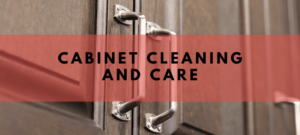
DAILY MAINTENANCE
Liquid spills should be cleaned up right when they occur on or in your cabinetry, and it’s best to avoid letting spills dry on your finish. For everyday clean-up on cabinets, clean them by wiping with a slightly damp soft microfiber cloth, and then immediately dry them with a dry soft cloth to remove any excess residual moisture. For stubborn stains, you can also add a small amount of mild dish soap to your water to help remove oils and grease from your cabinetry. Afterwards, remember to immediately wipe them dry with a soft cloth.
Pay special attention to areas around your sink and dishwasher, as these wet zones may need to be cleaned more often. Wipe any standing water on countertops, especially around the sink, faucet/taps, and countertop miters. Standing water can negatively affect your countertop seams and clouding can occur, especially on darker coloured granite countertops, resulting in a white haze from hard water mineral deposits. Click here for more information on Laminate, Quartz, Granite, and Wood Countertop Care, Maintenance, and Things to Avoid
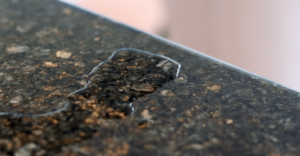
MONTHLY MAINTENANCE
To keep your cabinetry looking good, it’s recommended to wipe them down once a month, using the same techniques as mentioned previously. Areas around handles or knobs can get very sticky from grease, hand oils, and grime. This will also happen near the cooking zone, as grease from cooking can build up on cabinet fronts, especially those close to the stove or cooktop. Removing this residual grease is extremely important to do monthly, as leaving this to build-up can be difficult or sometimes impossible to remove even after a few months or years, depending on cooking behaviours.
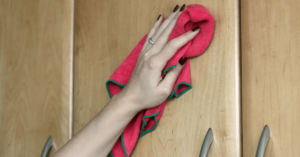
SPRING AND FALL MAINTENANCE
Spring and Fall is a good time to visually inspect the reveals and margins on cabinet doors and fronts, as some basic adjustments may be required. Remember, any moving parts [doors, drawers, pull-outs] will need to be adjusted. Click here for more information on how to adjust hinges and drawer glides/slides.
As part of regular required homeowner maintenance, it’s good to perform adjustments on your cabinet door and drawer fronts twice a year. This ensures that things are properly aligned and performing correctly and there are no binding doors or fronts, which can cause permanent damage. Remember, moving parts including door hinges, drawer glides and pull-outs need yearly adjustments, as this is natural with usage, shifts, and humidity changes in the home.
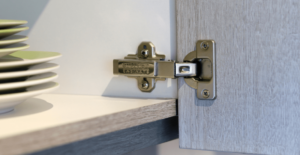
Maintaining balanced humidity in the home is important for your cupboards, as some cabinetry substrates or types tend to expand during humid seasons [Spring & Summer] and contract during dry, cold seasons [Fall & Winter]. Ideal humidity levels are 40-50%, which should be maintained throughout the year and not following these guidelines can void your manufacturer’s warranty.
REMOVING STUBBORN FINGERPRINTS
For stubborn contamination from hand oils or visible fingerprints on your cabinets that can’t be wiped off without deeper intervention, here are two advanced methods to consider.
[DISCLAIMER] These methods are only to be used for any cabinets finished with a professional furniture finish top coat such as a two-component or a catalyzed conversion varnish. Do not use these methods on any unfinished or wood alternative materials like Thermofoil, Laminate, TFL, or Melamine, as abrasives, solvents, lacquer thinners, or any products containing acetone will permanently damage these substrates. If you aren’t sure what substrate your cabinet fronts are made from, always consult with a professional first.
Alcohol-Based Hand Sanitizer: This can sometimes remove fingerprints, depending on how contaminated or severe. This can be done by dabbing some alcohol-based hand sanitizer on a clean, dry, microfiber cloth, then wiped into the surface, and then left to evaporate.
Mineral Spirits: This method can also help remove contamination in the finish or top coat. This can be done by dabbing a small amount on to a clean, dry cloth, then wiped into the surface, and then left to evaporate. Mineral spirits can be purchased from any home building supply, big box, or paint store. If you try this method, it’s recommended to test on an inconspicuous area, such as the inside of a cabinet door, or on a samples/test piece, if you can. Always use the recommended Personal Protective Equipment [PPE] including gloves and to follow the recommended safety procedures, including having proper venting, as this is a solvent.
It’s recommended to avoid any touching of the cabinet fronts. The decorative cabinet hardware is there to use for opening and closing and are essential to protect the cabinetry finish from hand oils.
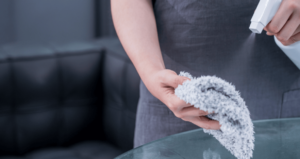
CLEANING CABINET INTERIORS
As an industry standard, most cabinet interiors or cases are made of Thermofused Melamine, also known as Thermally Fused Melamine. This is a durable, cleanable, and long-lasting material for cabinet case/box construction, especially if taken care of. Cabinet interiors should be cleaned/wiped with a slightly damp soft cloth, and immediately dried with a dry soft microfiber cloth to remove any excess residual moisture. Remember, always dry the surface immediately after cleaning, as excessive water left behind may seep down into the seams which will cause irreparable damage to this material. When cleaning cabinet hinges, use a soft dry cloth or a cotton-tipped swab in the smaller areas.
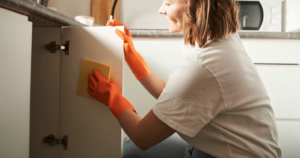
CLEANING HARDWARE [HANDLES/KNOBS]
High quality decorative cabinet hardware is typically finished with a protective coating, but this doesn’t make them invincible. Decorative cabinet hardware should be cleaned/wiped with a slightly damp soft cloth, and immediately dried with a dry soft cloth to remove any excess residual moisture. It is also important to dry the areas around the cleaned handle or knob immediately after. You can also protect the finish on your handles and knobs by avoiding contact with jewelry, as finger rings can quickly chip away at the protective coating and permanently wear or erode the finish.
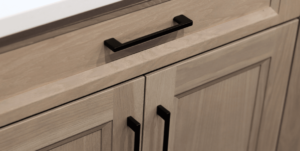
CLEANING GLASS DOORS
If you have glass inserts in your cabinet doors, they may be cleaned with window cleaner. Spray the cleaner on a clean cloth and wipe the glass clean. Never spray window cleaner directly on the door, as over-spray of the cleaner may damage the finish on the cabinetry surfaces. If you get some of the cleaner on the cabinetry surfaces, wipe immediately with a damp cloth followed by wiping with a dry cloth.
THINGS TO AVOID
Water and Moisture with Cabinetry: Never hang a wet dish cloth or dish towel over any cabinet doors or fronts. Eventually the moisture will cause permanent damage to your door. Do not leave any standing water, moisture, or liquids inside cabinet cases or on drawer bottoms. Again, all spills should be cleaned up right when they occur, as water, liquids, or moisture and cabinets do not go well together.
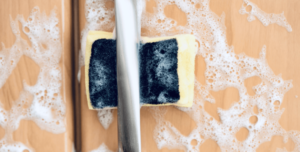
Touching Cabinet Fronts: Touching of cabinet fronts will eventually contaminate the cabinet finish from hand oils, showing visible fingerprints that can’t be wiped off without deeper intervention. This can happen on all cabinet substrates/types but is especially true for matte and dark cabinet finishes which can contaminate in a matter of a few months from touching them. Your decorative handle hardware is there to protect your cabinets from touching, so use them to avoid any hand contact.
Brass or Silver Cleaners on Hardware: These are not recommended for cleaning your cabinet handles, knobs, drawer slides, or decorative hardware. Some of these cleaning solutions contain harsh chemicals that can permanently damage the finish on your hardware.
Magic Eraser: Do not use a magic eraser or a melamine sponge on cabinets or countertops. This includes your cabinet doors/fronts, hardware, hinges, glides, or interiors. When a magic eraser is wet it’s equivalent to a 3000 – 5000 grit sandpaper, so this is never recommended.
Cleaners or Abrasives: Avoid using harsh detergents, cleaners containing ammonia, silicone, or bleach additives. Never use abrasive cleaners, scouring pads or powdered cleaners on any type of cabinetry or countertops.
Furniture Waxes or Polishes: It’s important to not use any furniture wax or furniture polish on your cabinetry. These products will contaminate or mar your factory finish or top coat.
Self-Cleaning Appliances: Self-cleaning appliances create a great deal of heat during the cleaning process, and residual heat or heat escaping through seals or gaskets can cause major damage to your cabinets. This feature heats the oven far beyond normal cooking temperatures, around ~470° Celsius [~878 Fahrenheit], and this excessive heat is terrible for cabinetry and laminate countertops. If you use this feature, it’s always recommended to pull the range/stove/oven out a minimum of 12” out from the wall. It’s also recommended to completely remove upper, lower doors and drawers that are directly beside the appliance while the self-cleaning feature is in use.
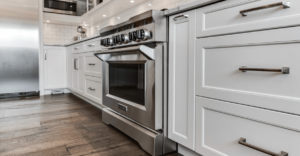
Appliance experts are seeing a shift away from the high heat self-cleaning option, as some manufacturers are adding a new additional Steam Cleaning option in certain models, also known as Low Temperature Cleaning. This new steam cleaning feature offers a chemical free, shorter, odorless experience that uses less power, perfect for intermittent cleaning. Some appliance experts feel that appliance manufactures will eventually be fully switching over to the steam cleaning/low temperature cleaning option in the future, but time will tell.
Steam and Heat Releasing Appliances: Appliances that release steam will damage your cabinetry if placed too close. Small appliances such as kettles, coffee makers, pressure cookers, toaster ovens, and any countertop appliances that produce excess heat and steam should be pulled out beyond the upper cabinetry, so that steam does not touch the cabinet fronts or cases/boxes. Click here for more information on the impacts of heat and steam on cabinets.
For some cabinet types like Thermofoil or Melamine/Laminate, it’s recommended that a filler or heat shield be installed between any door and drawer front and a range/stove/oven. Failure to do so will void your warranty, therefore it’s recommended to consult and plan your dream kitchen with a Professional Kitchen Designer.
Latest Articles
Custom Woodwork From Our Craftsman’s Bench to Your Home
Wedgewood Cabinetry is the highest quality custom cabinetry in Colorado. Our wood is locally sourced, which means it’s acclimated to the unique Denver climate, minimizing expansion, contraction, and discoloration throughout the entire lifespan of the cabinets. We offer exotic wood and inlays with unlimited design options, even providing our unique cabinet designs in a wide variety of material outside of wood, giving our Denver customers the unlimited potential to complete the look of your dreams.